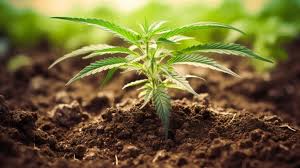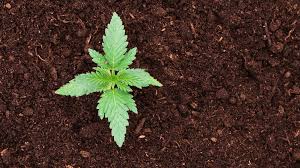Introduction
For those considering cultivating cannabis, understanding cannabis soil requirement is crucial. Just like any other plant, cannabis thrives in an environment that meets its specific needs. Providing the right soil conditions can significantly impact your plant’s growth, health, and ultimately, its yield. This guide dives deep into the world of cannabis soil, covering everything from choosing the ideal mix to maintaining optimal conditions for a flourishing crop.
Understanding Soil Basics
Before diving into cannabis specifics, let’s establish a general understanding of soil. Soil is a complex ecosystem composed of mineral particles (sand, silt, and clay), organic matter (decomposed plant and animal material), air, and water. The ideal ratio of these components creates a well-draining, aerated, and nutrient-rich environment for plant life.
The three main types of soil particles play distinct roles:
- Sand: Large particles that allow for excellent drainage but hold minimal nutrients and water.
- Silt: Medium-sized particles that offer a balance between drainage and water retention.
- Clay: Tiny particles that offer superior water retention but can impede drainage and air circulation.
The ideal soil for cannabis is a loam, a beautiful blend of all three particle types, typically in a ratio of 40% sand, 40% silt, and 20% clay. This combination provides excellent drainage, aeration, and the ability to hold both water and nutrients.
Read- Cannabis: The Fitness Boost
The pH Factor: Keeping it Just Right
Another critical aspect of healthy cannabis soil is pH. Measured on a scale of 1 to 14, with 7 being neutral, pH indicates the acidity or alkalinity of the soil. Cannabis flourishes in a slightly acidic environment, with a preferred range of 5.8 to 6.5. Soil outside this range can hinder the plant’s ability to absorb nutrients, impacting its growth and overall health.
Testing your soil’s pH is a simple process. Purchase a soil pH testing kit from your local gardening store or nursery. Following the kit’s instructions, you can easily determine your soil’s pH level and take corrective measures if necessary.
Adjusting pH:
- If your soil is too acidic (below 5.8), adding lime or dolomite will raise the pH.
- Conversely, if your soil is too alkaline (above 6.5), adding sulfur or organic matter like composted wood chips can lower the pH.
Remember: It’s always best to make adjustments gradually and retest the soil after a few weeks to ensure you’ve reached the desired pH level.
The Power of Organic Matter: Fueling Your Cannabis

Organic matter plays a vital role in healthy cannabis soil. Compost, aged manure, and worm castings are excellent sources of organic matter, providing essential nutrients for plant growth. These elements also improve soil structure, aeration, and water retention.
Benefits of Organic Matter:
- Nutrient Source: Organic matter slowly releases essential nutrients like nitrogen, phosphorus, and potassium, feeding your plants throughout their growth cycle.
- Improved Drainage and Aeration: Organic matter helps create space between soil particles, allowing for better drainage and air circulation to the plant roots.
- Water Retention: Organic matter acts like a sponge, soaking up and holding onto water, reducing the frequency of watering needed.
- Beneficial Microbes: Organic matter fosters a thriving population of beneficial microbes in the soil. These microbes help break down nutrients, making them readily available to your cannabis plants.
Adding Organic Matter:
- Aim for a blend that is roughly 20-30% organic matter by volume.
- You can purchase pre-made organic potting mixes specifically designed for cannabis cultivation.
- If creating your own mix, consider using a combination of compost, aged manure, and worm castings.
The N-P-K Trio: Essential Nutrients for Thriving Cannabis
While organic matter provides a good foundation, cannabis also benefits from additional nutrients at specific stages of growth. These essential nutrients are typically represented by a three-number code: N-P-K.
- Nitrogen (N): Crucial for vegetative growth, promoting strong stems and foliage.
- Phosphorus (P): Essential for root development and flower formation.
- Potassium (K): Strengthens plant cell walls, improves stress tolerance, and aids in bud production.
Understanding Nutrient Needs:
- Seedlings require minimal nutrients, so a light feeding or a mix formulated for seedlings is ideal.
- During the vegetative stage, focus on fertilizers with a higher nitrogen content to support strong foliage growth.
- As your plants transition to the flowering stage, switch to a fertilizer with a higher phosphorus and potassium
Building Your Cannabis Soil Mix: A Step-by-Step Guide

Now that you understand the key components of healthy cannabis soil, let’s get down to business and create the perfect mix for your plants! Here’s a step-by-step guide:
- Gather Your Ingredients:
- High-quality potting mix (preferably formulated for cannabis cultivation) – This forms the base of your mix and should already contain a good blend of sand, silt, and clay.
- Organic matter (compost, aged manure, worm castings) – Choose a combination that provides a variety of nutrients and benefits.
- Perlite – This volcanic rock adds excellent drainage and aeration to the mix.
- Coco Coir (optional) – This coconut fiber-based material offers great water retention and drainage.
- Proportions:
- Potting Mix: 40-50%
- Organic Matter: 20-30%
- Perlite: 20-30%
- Coco Coir (optional): Up to 10% (consider replacing some potting mix for coco coir)
- Mixing it Up:
- In a large container, thoroughly combine the potting mix, organic matter, and perlite.
- If using coco coir, dampen it slightly before adding it to the mix.
- Use a shovel or your hands to ensure all ingredients are evenly distributed.
- Testing and Adjusting pH:
- Before planting, it’s crucial to test the pH level of your soil mix.
- Follow the instructions on your soil pH testing kit and adjust the pH as needed using the methods mentioned earlier (lime/dolomite for raising pH, sulfur/compost for lowering pH).
- Let it Breathe:
- Once your mix is ready, it’s beneficial to let it sit for a week or two before planting. This allows the organic matter to break down further and the pH to stabilize.
Maintaining Optimal Soil Conditions: Watering and Feeding
With your perfect cannabis soil mix prepared, proper watering and feeding practices are essential for continued success.
Watering:
- Cannabis prefers consistently moist soil, but not soggy. Overwatering can lead to root rot.
- The frequency of watering will depend on factors like pot size, plant stage, and climate.
- A good rule of thumb is to water when the top inch of soil feels dry to the touch.
- Always water deeply until water drains from the pot’s drainage holes. This ensures all the roots receive moisture.
Feeding:
- While organic matter provides a good base of nutrients, cannabis may require additional feeding during its growth cycle.
- Use fertilizers specifically formulated for cannabis, following the manufacturer’s recommended dosage and schedule.
- Remember, less is often more. Overfertilizing can damage your plants.
Additional Tips:
- Mulch: Apply a thin layer of organic mulch around the base of your plants. This helps retain moisture, regulate soil temperature, and suppress weeds.
- Top Dressing: As your plants grow, you can top dress the soil with additional organic matter or slow-release fertilizer throughout the season.
Conclusion: Happy Growing!
By providing your cannabis plants with the right soil environment, you’re laying the foundation for a successful and rewarding growing experience. Remember, healthy soil is the cornerstone of healthy plants. With a little planning, preparation, and ongoing care, you can create the perfect recipe for your cannabis to thrive!